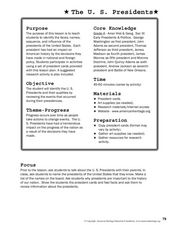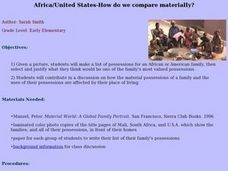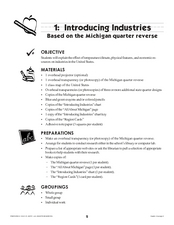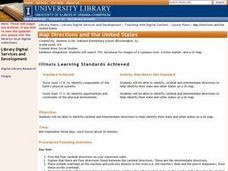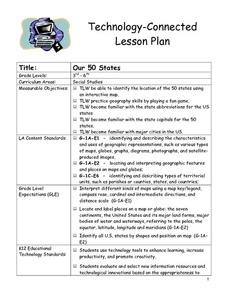Curated OER
How Will We Get There?
Students discuss and make a T chart of how to travel in Hawaii and understand that it is a group of islands that you cannot drive to. In this Hawaii lesson plan, students also discuss the kinds of transportation we use on the main land.
Curated OER
The U.S. Presidents
Students identify the Presidents of the U.S. by their physical characteristics and their impact on America. In this Presidents lesson plan, students read about each President, look at their pictures, and identify each of them based on...
National First Ladies' Library
Women's Place is in the House...and Senate!
Students investigate the different women who have served in the United States Congress. They discuss Senator Hillary Clinton, conduct Internet research, and in small groups complete a grid that compares and contrasts the women who have...
Curated OER
Statue of Liberty
Students make their own Statue of Liberty. In this Statue of Liberty lesson plan, students research the symbol of the United States, create a KWL chart for it, and cut and paste their own Statue of Liberty.
Curated OER
Africa/United States-How do we compare materially?
Young scholars discuss the material possessions of an African or American family. They examine how the material possessions of a family and the uses of their possessions are affected by their place of living.
Curated OER
Ten Crucial Days-How to Win a War You Should Lose
Students research the victories of Washington at Trenton and Princeton. In this Revolutionary War instructional activity, students investigate and discuss the factors of Washington's victories and use maps to identify the strategy...
Curated OER
Mapping Your State's Role in the Vietnam War
Students recognize reasons to celebrate Memorial Day. Students create a map of victims of the VIetnam War. Using the internet, students research information about soldiers from their state who were killd in action in Vietnam. Students...
Curated OER
Fifty States Field Day
Young scholars explore the 50 states in preparation for a special field day. On the actual field day, the oldest students in the school manage each of 50 physical activity stations. They share information about each state and introduce...
Curated OER
Introducing Industries
If you are looking for a way to explore Michigan's resources, physical features, and more, this lesson is for you. After discussing Michigan and the Great Lakes, learners fill out a graphic organizer identifying the state's natural...
Curated OER
Burr Airlines Flight to Asia: Building Inquiry Skills
What a wonderful way to explore this topic! Learners take an imaginary trip to Asia, take a visual tour, and formulate questions for a research project. As a final project, they create a travel brochure.
Curated OER
Designing Clay
Maria and Juliana are two of the most famous Pueblo pottery makers of the modern era. The class will learn about pueblo pottery design and the ways that Maria and Julian use traditional designs in a new and innovative way. They will...
Core Knowledge Foundation
The Viking Age Tell It Again!™ Read-Aloud Anthology
A two-week read-aloud anthology explores the Viking Age. Scholars complete lessons that include reading, discussion, extension activities, and take-home materials. Pausing points signal assessment opportunities.
Curated OER
I've Just Seen a Face: Portraits
Students examine portraits for different images they project, cite three purposes a portrait can serve, analyze portraits of historical figures, and relate biographical research to portraits.
Curated OER
Unite These States
Students explore the historical events and people associated with the 13 colonies. The geographic locations of the 13 colonies and ultimately, of all 50 states are investigated.
Curated OER
Map Directions and the United States
Third graders search TDC database for images of a compass rose, a miles marker, and a US map. They identify cardinal and intermediate directions to help identify their state and other states on a US map.
Curated OER
Egypt Technology Unit
Students research the architecture and history of mummies, hieroglyphics, tombs, and pyramids of Ancient Egypt. They watch a video, explore Internet websites, and write a sentence in hieroglyphics.
Curated OER
The Bill of Rights Today
Students discuss the Bill of Rights and how the Bill of Rights relates to everyday life. In this Bill of Rights lesson plan, students identify and explain each amendment.
Curated OER
Every Day Is Presidents' Day at the White House
Students explore the history of the White House and the role of the president. They explore the White House Historical Association website, answer questions, create a drawing of the Oval Office, and take an online quiz.
Curated OER
The Great Depression
Students are be able to analyze primary sources (photographs and letters) for evidence of difficulties children faced during the Great Depression. They are asked how the government tries to help people with problems that people face to...
Curated OER
Our 50 States
Students identify the location of the 50 states using an interactive map. They practice geography skills by playing a fun game. Pupils become familiar with the state abbreviations for the US states. Students become familiar with the...
Curated OER
Listening for Leschi: Voices from the Past
Students explore the written and oral histories of mid 19th centruy western Washington. They imagine that they are a reporter who can travel back in time and interview Leschi to create a newspaper article that features him.
Curated OER
Presidential Trading Cards
Learners research the Internet to collect data about the US Presidents. They use the data that they collect along with available technology to produce trading cards and brochures using keyboarding skills, text boxes, acquiring photos,...
Curated OER
Gettysburg Movie
Students create a movie that includes both sound and pictures of the Gettysburg Address using iMovie, digital cameras, and copies of the Gettysburg Address. Extensive examples of student works are given.
Curated OER
About the U.S.A.
Students research the United States and discover its different climate zones, geographical features, animal life, and various cultures. Students complete a research chart using books, encyclopedias and the internet and present their...

